When someone you know dies or someone you know experiences loss, it is customary to send sympathy plants to express your sorrow and support during this difficult time. Many people choose to have a florist make the selection for them, but you can make the plants you send more personal by understanding their meaning.
Popular sympathy plants for funerals include flowers such as lilies, roses, orchids, and more. Other plants include oak and dogwood trees and palm plants. Many of these plants symbolize love, care, and compassion.
In the rest of this article, I’ll discuss why funerals have sympathy plants, so you can better understand how this tradition came to be. I’ll also go through ten of the most popular kinds of sympathy plants and their meanings.
Why Do Funerals Have Sympathy Plants?
The tradition of sending sympathy plants and featuring plants at funerals has a long history, likely beginning around 80,000 years ago in Iraq. There, in the Shanidar caves, a male Neanderthal was discovered surrounded by the remnants of various wildflowers, including pollen deposits and flower fragments. After further research of the soil samples, Dr. Solecki, the excavation director, determined that the flowers were placed on the burial site.
Since then, flowers and other plants have played a role in funeral practices worldwide. Funeral director Lazarus C. Shepard famously used piles of funeral flowers to mask the scent of President Andrew Jackson’s body decomposition at his funeral in 1874. Indeed, one hypothesis for why this tradition began is that flowers’ pungent and pleasant odor disguises the smell of rot and decay from a body.
The tradition continued throughout the 1800s, especially in the Midwest. In this region, it was common to have a group of six “Flower Ladies” carry flowers from the funeral to the gravesite and arrange them on the plot. These women were considered on par with the pallbearers regarding their level of honor.
In modern times, now that embalming is a popular choice for people having a burial for their loved one, flowers aren’t necessary to disguise any odor. Still, they are used as decoration and expressions of love. For more information about embalming, I recommend reading my article on how long the effect of embalming lasts on a body.
Other modern-day uses for sympathy flowers include the following:
- Decorating the church or funeral service site for the service.
- Planting flowers near a crematorium.
- Planting flowers or shrubs on a gravesite to beautify the area.
- Bringing flowers to a gravesite on significant holidays or anniversaries.
The Neanderthals that first buried someone with plants likely wanted to honor the fragile nature of life by including fragile flowers alongside the corpse of the departed. By sending sympathy flowers, or other kinds of plants, today, you are clearly expressing your care and compassion for the departed and participating in a centuries-long tradition that unites humans all over the world.
10 Popular Sympathy Plants
Let’s discuss the ten most common plants to be included in a funeral and their symbolic meaning.
1. Lilies and Peace Lilies

The most popular sympathy plant is the lily or peace lily. Nowadays, many people send lilies for a funeral because they know it is a tradition to do so, but they are unaware of how this tradition came to be.
The Greeks and Romans connected lilies with innocence and rebirth, and in religious iconography, they often used images of the lily with any depictions of the Resurrection of Christ. Therefore, if you send lilies as your sympathy plant, you’re reminding the departed’s loved ones that their soul has been returned to a state of innocence.
Lilies also have a strong fragrance, so they likely grew in popularity for use in funerals before embalming was popular, and the flowers had to disguise the odor of the decomposing body.
Peace lilies are also popular because they represent peace after death and rebirth. This symbolic meaning comes from their growth pattern; these flowers die in the winter but come back to life in the spring. As a result, they are also often represented in depictions of Jesus Christ’s resurrection.
These beautiful flowers are a great choice to send for sympathy plants, not only because they are traditional and therefore unlikely to offend or seem out of place, but also because they have significant symbolic meaning. I suggest sending these flowers, particularly if the departed was Christian or Catholic.
2. Roses
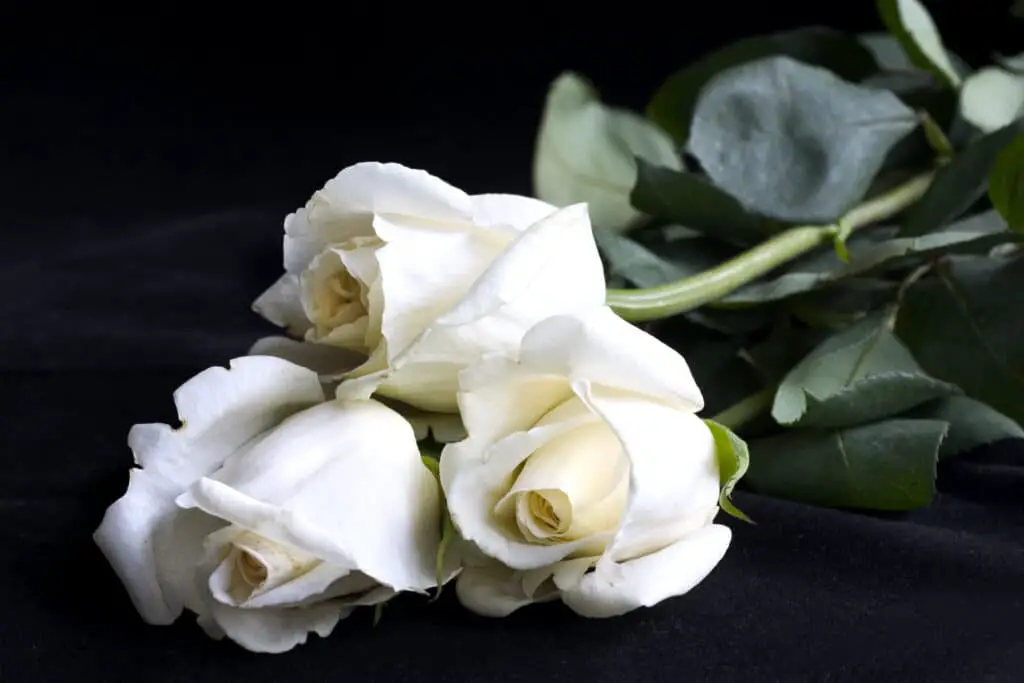
Roses are another popular choice for a sympathy plant. Not only are they beautiful and generally well-adored and admired, but you can also customize your sentiment for the departed based on the color of the rose you send.
The following table outlines the common meanings behind various rose colors:
| Rose Color | Meaning |
| Red | Passionate and romantic love, commitment |
| Pink | Elegance, appreciation, friendship |
| White | Purity, innocence |
| Yellow | Friendship, joy, loyalty |
| Orange | Pride, fascination |
Therefore, if you’re sending sympathy flowers for a departed friend, sending pink or yellow roses is a great way to express that relationship and personalize your sympathy plant.
3. Orchids
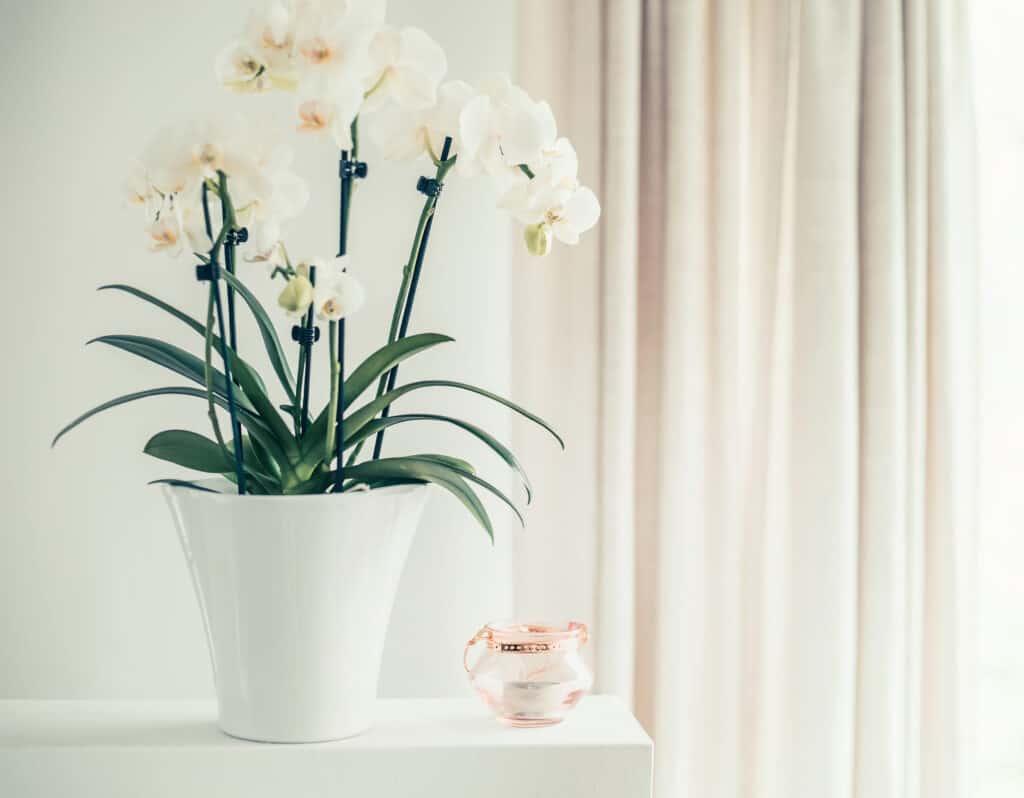
Orchids, above all, represent love, so if you want to express your love for the departed or their loved ones, you can’t go wrong with this beautiful plant. Orchids tend to last longer than other flowers on this list, so if you want to give a sympathy plant that will last beyond the service, I recommend choosing the orchid.
As with roses, different colors of orchids have various meanings associated with them. The following table will help you decide which is best:
| Orchid Color | Meaning |
| Pink | Innocence, grace, joy |
| Purple | Loyalty, respect |
| Orange | Pride, enthusiasm |
| Yellow | Joy, new beginnings |
| White | Innocence |
| Red | Romantic love, courage |
Typically, pink and white orchids are associated with sympathy, so if you’re on the fence about what color to choose, I would go with one of those.
4. Carnations
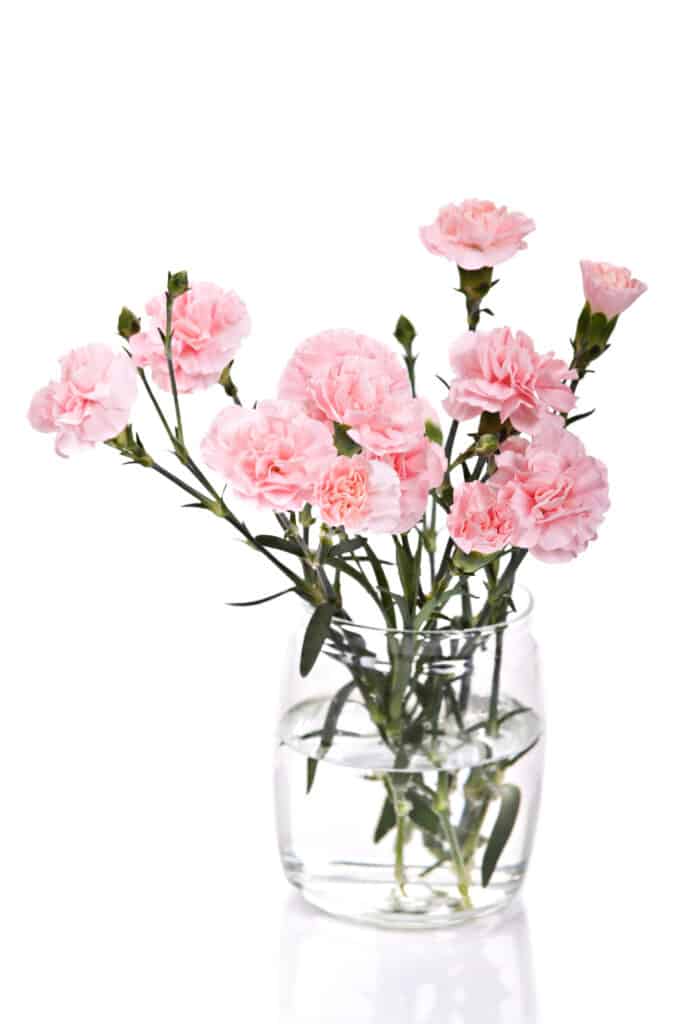
Carnations are beautiful flowers that are appropriate for a sympathy arrangement for anyone, especially those of Catholic belief. This association is because, in religious lore, it is believed that these flowers formed from the Virgin Mary’s tears.
They are also a great choice because they have a sweet, long-lasting fragrance that will fill any funeral home, church, or other site with a lovely smell.
Carnations are also popular because they are sturdy flowers that florists can shape into various shapes, such as sports logos or other shapes that may have some meaning to the departed.
Red carnations represent love, pink symbolizes remembrance, and white blooms are associated with innocence. Therefore, if you want to personalize your sympathy plant, consider these different colors and determine which is most appropriate for the departed.
5. Chrysanthemums
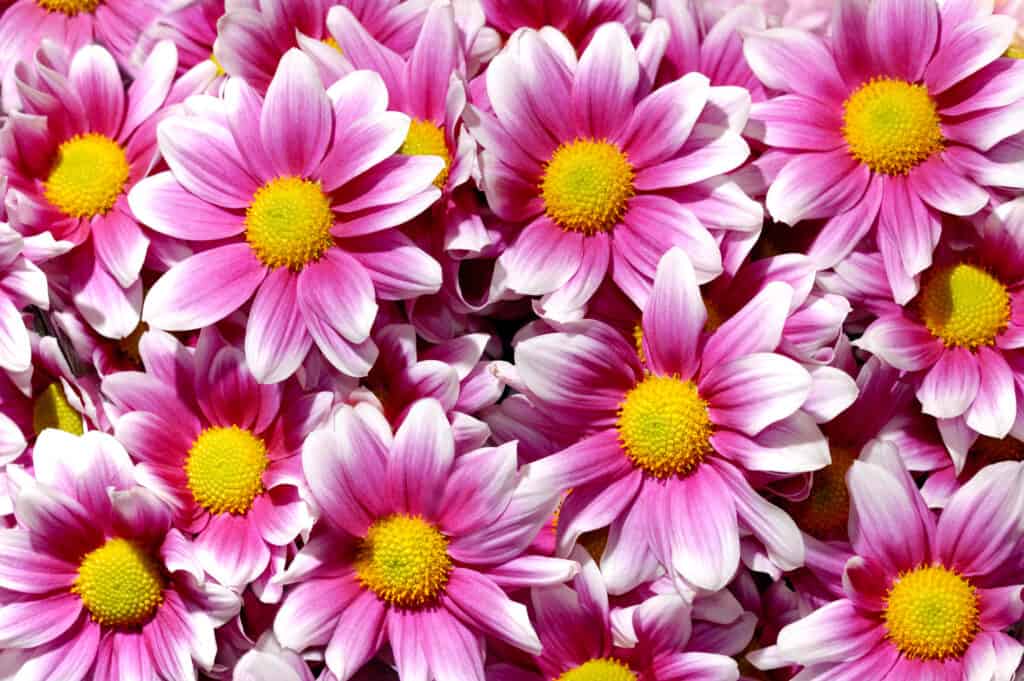
Chrysanthemums are common plants to send as expressions of sympathy, though they have various meanings worldwide. In the United States, they’re typically seen as fall flowers that symbolize happiness and well-being. However, chrysanthemums are tied to death and mourning in other areas of the world, such as Belgium, Japan, and Austria. Therefore, they are rising in popularity as a sympathy plant.
As with other flowers, such as roses and orchids, chrysanthemums come in various colors that influence their meaning. If you’re sending these flowers as a sympathy plant, I recommend getting them in white or pink, as these colors are tied more to mourning than the joy and friendship of other colors.
In Japan, China, and Korea especially, white chrysanthemums are common symbols of grief. It would be especially meaningful to send these flowers if the departed had ancestry in one of these nations.
6. Hyacinths
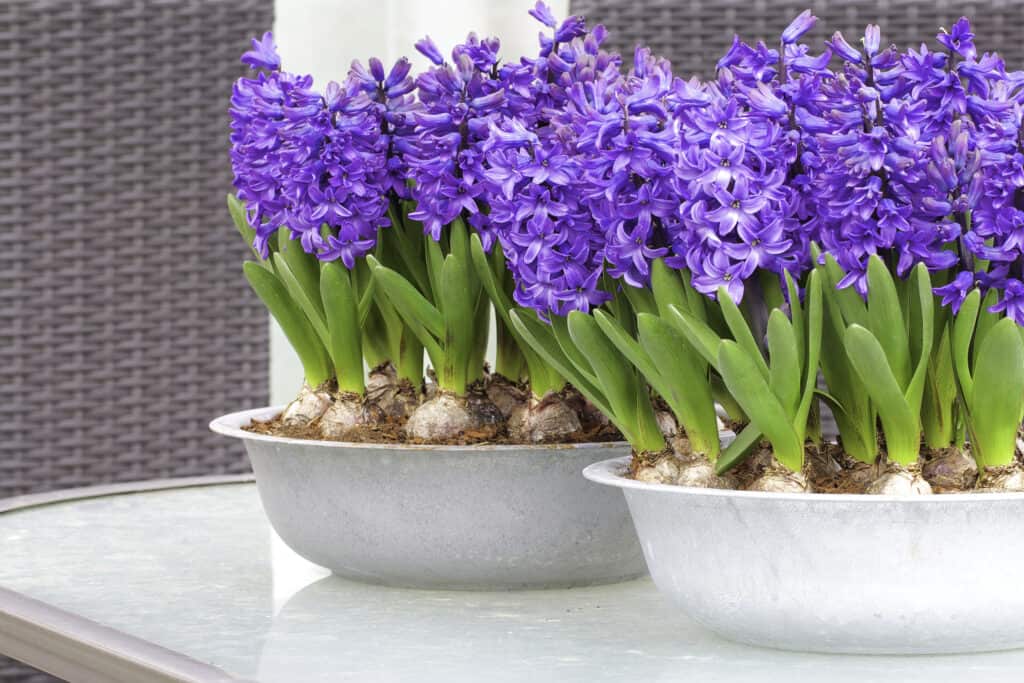
Hyacinths, particularly purple hyacinths, represent sorrow, so if you are feeling particularly sorrowful about the loss and want to express this grief, these flowers may be the ideal choice. They also have a sweet fragrance that is a welcome addition to any funeral home or church.
The meaning of these flowers comes from Greek mythology. As the story goes, the gods Apollo and Zephyr both loved a young Greek boy named Hyakinthos, and in jealousy, Zephyr throws a discus and accidentally kills Hyakinthos. Flowers then bloomed around the dead boy’s body, and Apollo named these flowers hyacinths to remember the boy.
Because of this origin, hyacinths are common flowers to send if you long for the departed and cared for them deeply.
7. Violets

Violets are often believed to symbolize everlasting love, remembrance, and innocence, which makes them an apt choice for a sympathy plant. They would be especially appropriate choices if the departed was a child or someone very young, as they are used in literature as a symbol of those who die too soon.
You can send many types of flowers as sympathy plants with various meanings that can help you express your grief and care for the recipient. If you need further guidance, I recommend reading my article on how to choose flowers for a funeral. However, flowers aren’t your only option for sympathy plants. Let’s take a look at a few non-flower options:
8. Palm Plants

Palm plants are believed to represent protection, so if you want to extend a feeling of comfort and protection to a grieving loved one, a palm plant can be the perfect sympathy plant. The plant symbolizes strength. Ideally, seeing this plant grow will inspire the grieving loved one to carry on.
A sturdy palm plant is likely to survive and thrive in various conditions. Seeing the continually growing plant can be a helpful reminder to the loved one that life goes on, even after someone we love dies. The loved one can take solace in the energy and endurance of the plant.
Just be careful not to add to their stress! Some palm plants can grow quite large, and if the person doesn’t have enough space to accommodate them, they’ll have to find a different place or rehome the plant. Therefore, it is better to do your research ahead of time to find an appropriately-sized plant.
These plants are a great choice because the family can display it at the funeral and then take it home with them after the service.
9. Oak Trees

Another great, non-flower option for a sympathy plant is an oak tree. Oak trees are often revered as symbols of strength and resistance because of their steady and consistent growth, which can make them an uplifting symbol of life carrying on after loss.
Additionally, some oak trees can live for 150 years or more, and the grieving loved one may find great comfort in knowing that even though the departed no longer lives, the tree planted in their memory will likely outlive them and contribute to the circle of life for years to come.
Many people who give oak trees as sympathy gifts also purchase a plaque that can be placed at the tree’s base to memorialize the departed. I recommend The Metal Foundry Custom Brass Memorial Plaque from Amazon.com because it comes with a garden stake for easy installment and because the wording is done in 3D, so the plaque appears high-quality. It is also completely lacquered, so it can endure the elements.
The family may choose to display the oak tree sapling at the service and plant it later, or they might even include the planting of the oak tree as part of the service.
10. Dogwood Trees

Another popular tree to plant to memorialize a loved one is a dogwood tree. These trees symbolize birth and resurrection. Indeed, by planting a tree in remembrance, you are resurrecting the spirit of the departed in a small but significant way.
The tree also symbolizes the ongoing circle of life, which someone in grief may find greatly comforting. The creamy white flowers are also associated with innocence, which many will find solace in.
Most dogwood trees grow to be nearly 30 feet (9 meters) tall, so planting this kind of tree is a surefire way to ensure that the departed are never forgotten and always watching over those still here on Earth. Like oak trees, most dogwood trees are planted with a plaque at the base stating the name, birth date, and death date of the departed. This way, even after many years, those who visit the tree will know who to remember and thank for its presence.
